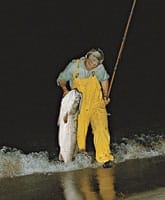
||
|—|
||
|Photo: Courtesy of Frank Daignault|
The Pro: Frank Daignault
Credentials: Author of Easter Tides and the Trophy Striper
Home Waters: Rhode Island & Cape Cod
Largest Surft-Caught Bass: 53 pounds.
Line of Choice: Braided lines have really evolved over the years. I ccurently use 50-pound Berkley Whiplast Super Braid. If that diameter is too thin for you, go to 65-pound.
Rod and Reel: I like the Abu Garcia 7000C3 because it has a high lie capacity. The level-wind is not a problem. I use a very stiff rod that is nine feet, three inches long. Longer rods are tiring. You may cast and extra yard, but you’ll quit much earlier.
Time of Year: I happen to fish where the bass spend the summer and many fishermen complain about the “doldrums.” June through October is best, but the sleeper that always makes me laugh is August.
Favorite Location: The Rhode Island surf anytime between June and October. I have some other pets like Cape Cod Canal and Narragansett Bay that are old-man easy.
Ideal Conditions: A quarter-moon night with some cloud cover is excellent. I’d be fishing at an outflow point late in the tide when the current is slowing. The big fish will move in to keep their noses in the current. Two to four nights after the new moon can also be very productive.
Rookie Mistake: A lot of anglers have a habit of getting themselves into extreme situations, like wading very rocky shorelines or in wild water, and having absolutely no plan whatsoever for landing a cow once it’s hooked.
Must-Have Lure: I love rigged eels because they are fished like a lure. They can be worked at various speeds and depths and will really move big bass.
Biggest Goof: I once failed to palm an old fly reel enough during a flight with a cow and it caused the backing to knot up. Then it severed at the reel and the fish took all my fly line. Sand eel flies were the only thing that had worked all night, but were useless without fly gear.
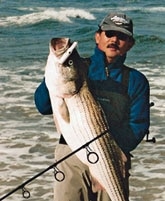
|
|Photo: Courtesy of Alberta Knie|
The Pro: Alberto Knie
Credentials: IGFA line-class record holder for a 45-pound bass caught on eight-pound line.
Home Waters: Long Island, NY
Largest Surf-Caught Bass: 54 pounds
Line of Choice: In rocky areas, I’ll go with 65-pound Sufix Performanc Braid with an 80-pound mono leader. People say it’s overkill, but I’ve had too many big bass out-muscle me with lighter line.
Rod and Reel: Just give me a reel with a large-capacity spool and a smooth drag that can take a lot of abuse. I like a big Lamiglas GSB blank with titanium or carbide guides. The important thing is to make sure your rod is perfectly balanced with your reel.
Time of Year: The biggest bass finish spawning by late May or early June. This is when they gorge on really big baits like bunker, or I find them around areas loaded with tautog and fluke.
Favorite Location: Anywhere from Great South Bay to Montauk. That’s all you’ll get out of me.
Ideal Conditions: I catch my biggest fish during new moon phases. On these very dark nihts, the bass get careless and venture close to shore. The few minutes after slack tide are ideal, and the water would be in the high 50s. Wind? Absolutely from the north or east.
Rookie Mistake: Most people panic and tighten the drag when a cow strikes. You have to relax and play thef ish for as long as it takes. Keep pressure on and take every inch that striper gives you.
Must-Have Lure: Undisputedly it would be a seven- or nine-inch paddle-tail rubber shad. I can work them at any speed or depth. They also create a perfect silhouette and the tail emits a nice vibration that the stripers can feel.
Biggest Goof: Trying to be in two places at one time. It wasn’t easy explaining to a police officer that I was speed to catch the right tide.
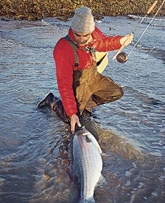
|
|Photo: Courtesy of Lou Tabory|
The Pro: Lou Tabory
Credentials: SWS “Surf & Jetty” columnist; author of Inshore Fly Fishing and Stripers on the Fly
Home Waters: Cape Cod & Rhode Island
Largest Surf-Caught Bass: 52 pounds
Line of Choice: When I use swimming plugs, I go with 30-pound braid because it gives a solid hookset. Mono tangles less, so I’ll use it in 20-pound when throwing poppers or needlefish.
Rod and Reel: It’s all about line capacity. I like a big spinning reel that will hold at least 250 yards of 20-pound line. A beefy ten-footer is the perfect rod for casting lures up to four ounces. Just make sure thte stick is somewhat limber so it doesn’t wear you down.
Time of Year: In recent years June has been very consistent for me in my home area, but I still like the fall for big bass. The first two weeks of October are usually prime in most of my favorite places.
Favorite Location: The oceanfront beaches of Cape Cod, Nantucket and Martha’s Vineyard are my favorites. When conditions are right, you feel like there is the potential to hook a big bass on every cast.
Ideal Conditions: The darker the better, so I prefer the new moon, except when there is phosphorus in the water. A full moon will reduce its negative effects. I like one- to four-foot seas with a light offshore wind. My favorite time is just before first light on a quiet section of beach.
Rookie Mistake: Guys don’t follow a hooked fish down the beach. The shorter the line, the less weed it collects, the fewer tangles occur with other anglers and the more pressure you can keep on the bass.
Must-Have Lure: An Atom 40 is tough to beat. A Junior Atom is more universal, but big bass like big baits.
Biggest Goof: I once borrowed a reel to surf fish the Bahamas and didn’t check it before casting. After a long fight with a 50-pound baracuda I realized there was a groove in the bail roller and the line eventually wore through. That’s why you should always check your gear.
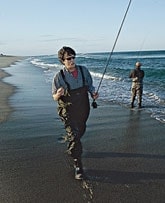
|
|Photo: Courtesy of Tony Stetzko|
The Pro: Tony Stetzko
Credentials: Maker of the Mr. Wiggly plug; former IGFA all-tackle striped bass world-record holder
Home Waters: Nauset Beach, Cape Cod
Largest Surf-Caught Bass: 73 pounds
Line of Choice: These days I strictly use 20- to 40-pound braided line. It really helps take away a lot of fear when you’re fighting a big bass. You can get far more on the spool and having no line stretch is a big plus.
Rod and Reel: Without a Van Staal 150, I don’t nkow if I could fish anymore. I’m hard on reels and they can take a beating. I like an eight- or nine-foot St. Croix Avid. The lighter rods let you keep better contct with your lure and won’t hurt your wrist.
Time of Year: For truly large bass, October through mid-November is the best. Schools won’t be hunge, but the bass will be big-50 pounds.
Favorite Location: I’ve fished for striped bass all over, but my favorite area is right here at home between Nauset and the cut in Chatham on Cape Cod.
Ideal Conditions: During the darkness of the new moon, you don’t have to worry about the fish becoming skittish. At Nauset Beach I’ll take a southwest wind 24-7, all year long. That direction will flatten the surf and make for easy casting. It also puts the bait right up on the beach.
Rookie Mistake: You can’t wade right on top of big bass while trying to land it. The best thing you can do when it’s close is back up a good 15 feet and use the waves to surf the fish onto the beach. If it runs again, just let it go and take your time.
Must-Have Lure: I grew up fishing with eels and my father developed the Mr. Wiggly back in 1977. It’s a wooden plug that mimics an eel, and I never hit the beach without one. It’s really versatile and unique.
Biggest Goof: I was nearing the end of a fight with a big bass and I was doing everything right-that is until I caught sight of the fish. I’m sure it hit the 100-pound mark and seeing it broke my concentration. as I gawked, my line ran over a mussel bed and was cut instantly.
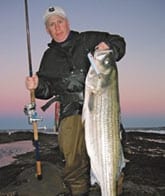
|
|Photo: Courtesy of Mike Everin|
The Pro: Mike Everin
Credentials: Field tester for Hab’s and Tattoo Lures; noted trophy striper hunter
Home Waters: Newport, Rhode Island
Largest Surf-Caught Bass: 63 pounds
Line of Choice: Where I fish, nothing beats 20-pound Yo-Zuri Hybrid. I don’t like braid because it cuts too easily on the rocks. The fluorocarbon has more abrasion resistance, and I like the stretch. Braid will straighten a hook.
Rod and Reel: Nothing compares in durability to the Van Staal 250, and the drain holes keep sand and water out. I need a big rod to heave big lures, so I go with a Lamiglas Ron Arra 1205. You need that power to move giant bass around the boulders where I fish.
Time of Year: In September, the bunker are in and the bass are beginning to migrate. This is when ou have the best shot at hooking into a big fish around Rhode Island.
Favorite Location: I love Newport, but my favorite spot is Cuttyhunk Island. If you want to catch a big bass, go there. That’s where I got my 63-pounder.
Ideal Conditions: I look at conditions liket his: I can either fish in them or I can’t. I don’t really have favorites, but right before or after a big storm is great. It churns the water and the bait comes out of hiding. I don’t worry about tides and moon-there’s always food in the rocks.
Rookie Mistake: Too many fishermen will just haul in cow without giving her a chance to tire. There comes a time in the fight when you have to use force so she doesn’t put you in the rocks, but you have to know how to recognize that moment and wait for it.
Must-Have Lure: I’ve thought about this many times, and I’ve decided it would be a white Hab’s Needlefish, especially for really big bass. Most of their forage has a white belly, so that lure is very versatile for mimicking many things they eat.
Biggest Goof: That’s easy. Following the crowd and using braided line. I have lost way too many big fish on that stuff.









